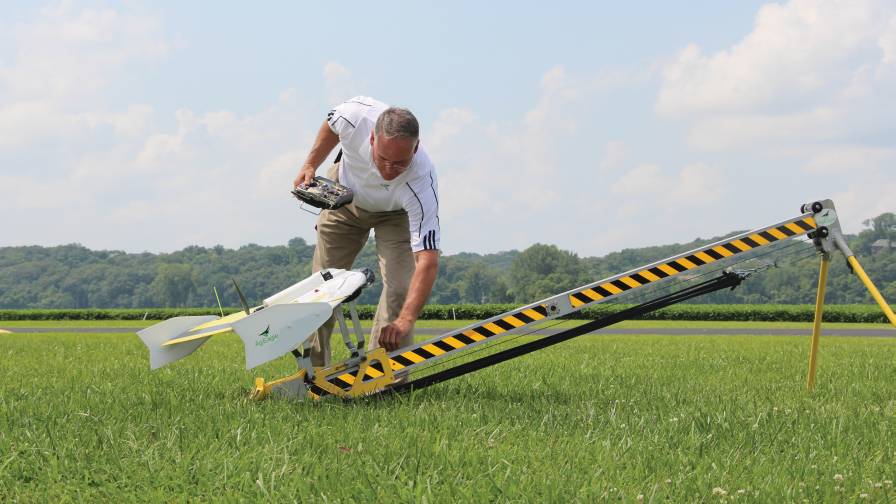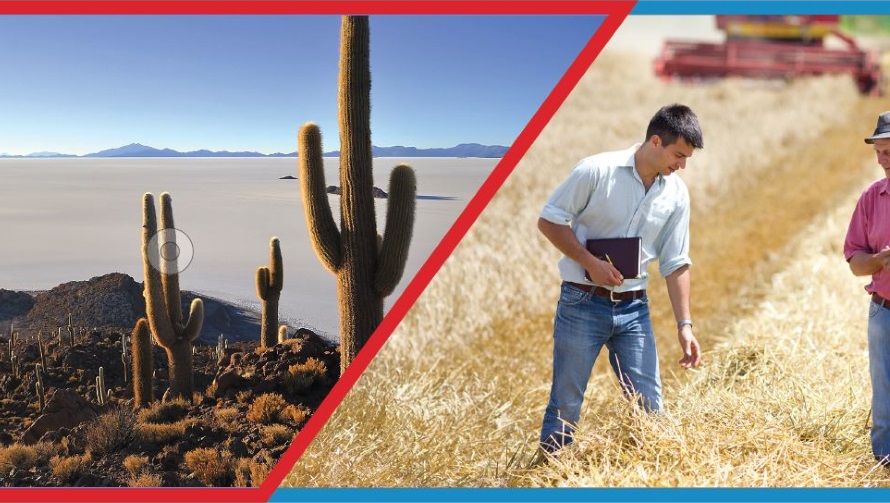UAVs 2016: Ag Retail Should Lead

Now is a good time ag retailers to learn now to implement drone technology into their offerings. Pictured is AgEagle founder Bret Chilcott during the 2015 InfoAg pre-show tour near St. Louis, MO.
With many expecting FAA to announce preliminary commercial regulations in the next few months, if not sooner (the agency recently extended the Section 333 exemption flight ceiling to 400 feet and rumors are flying that it will consider allowing flights over small groups of people), now is looking like the prime time for ag retail to truly figure out how it intends to implement drone technology into the tried-and-trued trusted advisor portfolio.
“Whether it’s the equipment dealer or the input supplier for N, P, and K, I think that just like farmers are trying to build ROI or find new ways to save time or save money, I think that the retailers are going to be looking at finding additional revenue streams and look for ways to continue to build value for their growers,” said Matt Barnard, Crop Copter Owner & CEO, during Commodity Classic back in March.
Barnard, a University of Illinois graduate and former seed industry leader that farms corn and soybeans with his family in Foosland, IL, views his team at Crop Copter as “the old man in the room” since the company has been working on precision agriculture applications for its multi-rotor and fixed-wing mixed fleet for the past four years. He feels that after four years of many long nights pondering how drones would ultimately fit into the farm scape, the ag retailer is the most logical choice to lead the way.
“To me, that ag retailer that’s already good at building value and being the trusted advisor, that agronomist, I think that’s the first opportunity (for UAVs in agriculture),” he explained. “So who’s it going to be, when is it going to be, and what is it going to look like? That’s yet to be determined. But I think if retailers wait for it to be fully cooked, you’re going to be way behind, because there’s plenty of people already out there learning about them. I’m not advocating anybody go out and buy a fleet of these things tomorrow, but you better have somebody in your organization playing with them.”
Implementing a drone imagery service at the retail level not only provides another revenue stream for retailers, but it also gives the trusted advisor a success story they can share with growers that are perhaps tired of hearing about depressed commodity margins and jacked up seed costs.
“There are retailers all across the Midwest that have adapted and adopted it and are growing their businesses, and the cool thing that I see from those guys is that they have something right now that’s very positive to talk about with their growers at a time where, let’s be honest, it’s not always a lot of fun to talk to them,” said Barnard.
“I don’t like $3.50 corn as much as the next guy, but when prices go down it’s just like a pond in a drought — you get all of your rocks exposed. So we have an opportunity to clean those rocks up, or we have an opportunity to ignore them, right? To me, I look at it as an opportunity to look back at our balance sheets and see some things that we are doing right and that we are doing wrong, and something that before maybe didn’t make as much sense, now all of a sudden you can have a positive ROI.”
The Unmanned Farmer Weighs In
Robert Blair, a well-known drone pioneer from Idaho and now-Measure VP of Agriculture, took some time during a recent mid-March drive from Pocatello, ID, down to Salt Lake City, UT, to discuss his feelings on the upcoming drone revolution in agriculture.
“FAA is supposed to come out with their commercial rules and regulations very soon, and I see that as being one of the bright spots,” Blair says when asked his take on the current state of drone usage in agriculture. “What they are going to look like, we don’t quite know yet, but I think we’re going to both be pleased in some ways and disappointed in others, that’s my sense of it. I think agriculture still needs some things — like beyond line of sight, improved ceiling height to operate at, and easier access to flying in restricted airspace in rural areas. Those are going to be some key issues.”
Blair says that beyond that, with the announcement from Yamaha that it is working on an Section 333 Exemption and FAA Certificate of Authorization for its aerial spray application drone RMax — as well as recent news that consumer drone giant DJI is launching its Agras MG-1 crop spraying octocopter to the U.S. market — much remains to be sorted out on the regulatory side before we have fleets of multi-rotor drones applying crop protection products in the Midwest.
“Where is that going to fall in the regulatory realm,” Blair wonders. “If we take a look at the application side of things, usually application regulations fall on each states department of agriculture. How will that be coordinated when it is a UAV doing the spraying? Is FAA working on rules for that? And if they do have rules for that, then it becomes a question of how can drone users comply with labels, and comply with all the regulations for application? There’s still a lot of legwork to do, but the nice thing is the regulations, getting those in place this year is the first step.”
Tom Gemmell, Partner attorney with Kansas City-based civil law firm Husch Blackwell and a former Air Force pilot, recently hosted a webinar on the upcoming FAA commercial drone regulations. Gemmell offered his thoughts on the future legalities of aerial crop spraying in the U.S. with drones.
“It will be a go,” he says. “The current limit for exemptions under Section 333 are aircraft with total gross weight under 55 lbs., including payload. To the extent an operator who petitioned for and received an exemption for commercial use of UAS for crop spraying can meet that weight restriction, and comply with other regulations relating to crop spraying, the operator can currently do so.”
Gemmell says to look for FAA to perhaps ease up on the weight restriction for application operations that can prove airworthiness while safely delivering crop protection payloads.
“The other option that is currently moving forward is a civil COA for commercial spraying in the U.S.,” he adds. “As you may know, the Yamaha RMax UAS is currently going through the process of obtaining a COA, and Yamaha has been at the forefront of lobbying Congress for the RMax’s expedited use. Based on the history of safe use in Japan and elsewhere, I expect RMax will be granted a civil COA within a year and be approved for commercial crop spraying in the U.S. Other platforms, such as the Dragonfly, are also seeking authorization.”
Blair, meanwhile, agrees with CropCopter’s Barnard that the ag retailer will be best positioned to make all of these big promises on ROI a reality.
“My message to them is: Will it save you time? And if you plan on flying drones yourself or having your agronomists fly drones, it probably will not save time, because now it is another job for that crop advisor/agronomist to do. Not only go out there and fly, but then look at the data, process and interpret it and then get back out there to the grower and go scout the field.
“Where it can be useful is, I think is from a third party,” he continues. “That’s why the business model is as a service. I know from my own experience on my own farm there are those time constraints — should I be working in the shop? Should I be out in the field doing work? Do I need to fly a drone and maybe miss my kid’s ball games or other functions with family? I think being able to have someone provide that information as a third party will be extremely useful for the crop advisor, and it will save time.”






